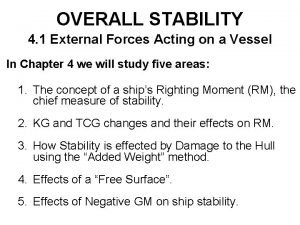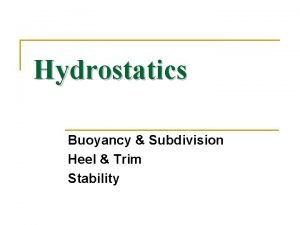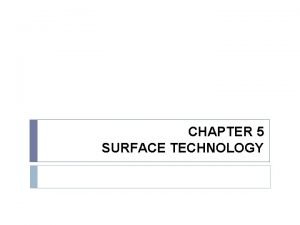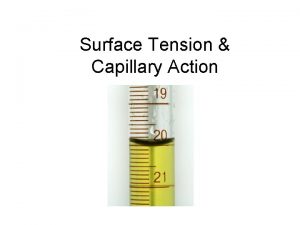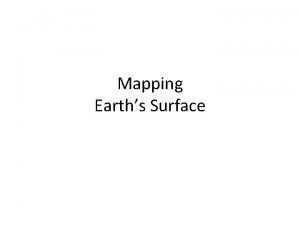FREE SURFACE CHAPTER 7 Effect of free surface












- Slides: 12

FREE SURFACE CHAPTER 7

Effect of free surface of liquids on stability Moment of statical stability = W x GZ = W x GM x sin θ◦

Effect of free surface of liquids on stability Now consider the same ship floating at the same draft and having the same KG, but increase the depth of the tank so that the liquid now only partially fills it

Effect of free surface of liquids on stability Moment of statical stability = W x G 1 Z 1 = W x G v. Z v = W x G v. M x sin θ◦

Effect of free surface of liquids on stability • • This indicates that the effect of the free surface is to reduce the effective metacentric height from GM to Gv. M. GGv is therefore the virtual loss of GM due to the free surface. Any loss in GM is a loss in stability. If free surface be created in a ship with a small initial metacentric height, the virtual loss of GM due to the free surface may result in a negative metacentric height. This would cause the ship to take up an angle of loll which may be dangerous and in any case is undesirable. This should be borne in mind when considering whether or not to run water ballast into tanks to correct an angle of loll, or to increase the GM. Until the tank is full there will be a virtual loss of GM due to the free surface effect of the liquid. It should also be noted that even though the distance GG 1 is fairly small it produces a relatively large virtual loss in GM (GGv).

Correcting an angle of Loll First make sure that the heel is due to a negative GM and not due to uneven distribution of the weights on board. For example, when bunkers are burned from one side it will obviously cause G to move to G 1, away from the centre of gravity of the burned bunkers, and will result in the ship listing

Correcting an angle of Loll it will be necessary to lower the position of the effective centre of gravity sufficiently to bring it below the initial metacentre: • Any slack tanks should be topped up to eliminate the virtual rise of G due to free surface effect. • If there any weights which can be lowered within the ship, they should be lowered. For example, derricks may be lowered , oil in deep tanks may be transferred to double bottom tanks.

Correcting an angle of Loll • Which double-bottom tanks Should be filled first? consider the effect on stability during the filling operation: • Free surfaces will be created as soon as liquid enters an empty tank. • This will give a virtual rise of G which in turn will lead to an increased negative GM and an increased angle of loll. • Therefore, if it is decided that it is safe to use the tanks, those which have the smallest area can be filled first so that the increase in list is cut to a minimum. • Tanks should be filled one at a time.

Correcting an angle of Loll • If the high side is filled first the ship will start to right herself but will then roll suddenly over to take up a larger angle of loll on the other side, or perhaps even capsize. • filling the low side first. Weight will be added low down in the vessel and G will thus be lowered, but the added weight will also cause G to move out of the centre line to the low side, increasing the list. • Free surface is also being created and this will give a virtual rise in G, thus causing a loss in GM, which will increase the list still further.

Correcting an angle of loll Figure (a) shows a ship at an angle of loll with the double-bottom tanks empty and in Figure (b) some water has been run into the low side. The shift of the centre of gravity from G to Gv is the virtual rise of G due to the free surface, and the shift from Gv to G 1 is due to the weight of the added water.

Correcting an angle of Loll • It can be seen from the figure that the net result is a moment to list the ship over still further, but the increase in list is a gradual and controlled increase. • When more water is now run into the tank the centre of gravity of the ship will gradually move downwards and the list will start to decrease. • As the list decreases, water may be run into the other side of the tank. The water will then be running in much more quickly, causing G to move downwards more quickly. • The ship cannot roll suddenly over to the other side as there is more water in the low side than in the high side. • If sufficient weight of water is loaded to bring G on the centre line below M, the ship should complete the operation upright.

Correcting an angle of loll (summary) • (a) Check that the list is due to a very small negative GM, for example 0. 05 to 0. 10 m. • (b) Top up any slack tanks and lower weights within the ship if possible. • (c) If the ship is still listed and it is decided to fill double-bottom tanks, start by filling the low side of a tank which is adequately subdivided. • (d) The list is bound to be increased in the initial stages. • (e) Never start by filling tanks on the high side first. • (f ) Always calculate the effects first before authorizing action to be taken to ballast any tanks.
 External forces on the statical stability
External forces on the statical stability What causes free surface effect
What causes free surface effect Free surface of liquid
Free surface of liquid Bohr's effect in respiration
Bohr's effect in respiration Founder effect vs bottleneck effect
Founder effect vs bottleneck effect Marshallian demand function
Marshallian demand function Chapter 9 surface water answer key
Chapter 9 surface water answer key Lateral area triangular prism
Lateral area triangular prism Spin coat
Spin coat Curved surface area and total surface area of cone
Curved surface area and total surface area of cone Surface free energy
Surface free energy How to calculate gibbs free energy
How to calculate gibbs free energy How to calculate gibbs free energy
How to calculate gibbs free energy
